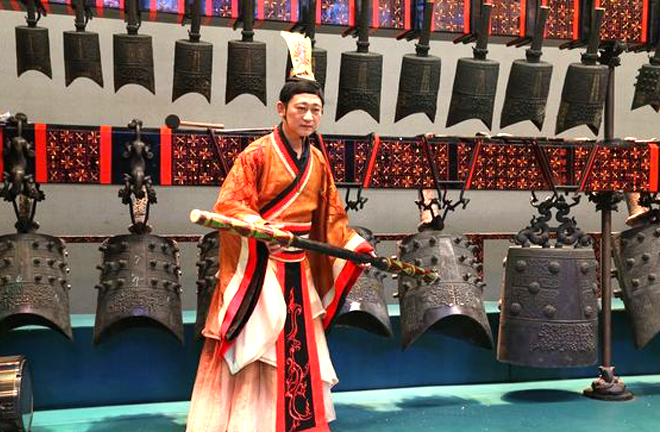System of rites, music inspires modern ethos

A performer holds a stick used to play the large chime. The chime set, a symbol of hierchary and power, is an important percussion instrument used only by the upper class in ancient China.
Chinese traditional rites and music are aspects of an orderly system that codify personal, social and familial aspects of society, and affect the ways in which people interact with the nation and the universe.
For individuals, etiquette and music are an expression of emotions in life, and affect the way that people approach life and death. In terms of social relations, rites and music are accompanied by all aspects of human interaction, as these are the ethical norms of all human relations. For nations, these rites and music contribute to the national order, and are the form for individuals’ emotional attachment and political identification with their country, said Yu Kailiang, a professor of philosophy at the Renmin University of China.
The rites and music system originated from the order and harmony of heaven and earth, the metaphysics of which embody transcendental humanity, Yu added.
Zhang Fa, a professor from the School of Humanities at Zhejiang Normal University, pointed out that rites contain the beliefs and politics of ancient Chinese social governance and express them in the form of beauty. At the same time, rites integrate belief and political identification into the ideological, material and ritual systems, the core of which is harmony.
Liu Chengji, a professor of philosophy at Beijing Normal University, said for individuals, rites refer to the grace of human behavior; for groups, they refer to ceremonial sacredness; for countries, they indicates the order of public life. The “music” specifically refers to the artistic forms of poetry, music and dance, as well as the happiness obtained by people from poetry, music and dance. In their symbolic meaning, rites and music refer to the harmonious coexistence of the entire community.
As Song Dynasty scholar Cheng Yi said, literally speaking, rites refer to order and music that emphasize harmony. Pursuing order and harmony is the essential demand of the traditional Chinese culture of rites and music. This pursuit is also the basic principle based on which Chinese people cultivate their hearts, set up social customs, construct a national political system, and coordinate the relationship between man and nature.
Rites and music have shaped many aspects of traditional Chinese culture. Liu said that the system of rites and music was closely related to sacrificial activities in ancient China. By the Western Zhou Dynasty, this ceremonial activity of worshiping ancestors and gods of heaven and earth had been pioneered in real politics, so there was a system of rites and music that influenced thousands of years of Chinese history.
Yu said the traditional culture of rites and music helped shape the material and artistic system of rites and music, such as sacrificial vessels, etiquette, poems, music, dance, costumes, architecture and ancient laws and regulations, while forming the characteristics of unification of sense and sensibility, and beauty and goodness through intrinsic emotional experience. The rite civilization derived a set of ethical and moral concepts that had a profound impact on China, such as benevolence, loyalty, filial piety, humility, respect and integrity. These concepts extended to state governance, infusing the ancient political culture with flexibility and humanity.
Liu argued that with the help of rites and music, the overall attributes of Chinese traditional civilization can be effectively grasped. The requirements of proper etiquette as it relates to individual’s morality and respect on heaven and earth is a reference for people today who seek to find an answer to moral issues. Music in the system uses joy and harmony to give lessons on optimism and harmonious relationships. This helps to address the spiritual anxiety and loneliness of modern people, and is also of great help to establishing good social relations.

 PRINT
PRINT CLOSE
CLOSE